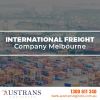10 Characteristics Which Determine LTL Freight Quote
We are continuing our sequence on LTL shipping to ensure that you are enlightened on what characteristics forms an LTL freight quote. The extent to which you are aware of what goes into an LTL freight quote, the better it will be for you to deal with what you expect as well as organize your freight shipment procedure to get the highest save on expenditure and charges in your transport division.
Due to the large number of factors that make up LTL freight quote, you have lots of choices to make and so make less than truckload shipment shipping a higher preference and a more appealing mode method for many transporters to increase direction, workability, and visibility into the management of their shipment.
Later on, we will go on with our sequence which deals with what the components or factors that constitute LTL Freight class are. These details are very important in ensuring that you get the best and most correct LTL freight quote when desire to ship LTL.
The Components of LTL Freight Quote
LTL shipments usually weigh between 151 and 20,000 lbs. LTL shipper will always put a price cut on shipments as the freight goes up in weight, this means there are different "weight break" price-cuts an LTL shipper could offer. Loads bigger than 5 pallets are still capable of been transported with an LTL carrier but these moves are generally considered volume moves and are spot quoted by the carrier’s rate department.
LTL freight quote can be extremely complicated. It is nothing like truckload which have got quote typically established on a mileage charge or a cost per-hundred weight in addition to a gas charge, many issues could regulate LTL quote which will most certainly impact the price of a delivery.
Less-than-truckload (LTL) method of shipping is utilized for small shipments that are too large to be delivered as bundle but also too little to fill up a complete truckload. LTL shippers assembles shipment from different shippers and combine that freight on trailers for line-haul to the delivering terminal or to a hub terminal where the shipments will be arranged and merged for further line-hauls.
Often times, drivers begin the day by packing and moving out to deliver parcels first, after that they start making pickups once the trailer has been cleared to go back to the terminal for arrangement and delivery for the day after. Hence, most pickups are done at noon and most deliveries are carried out at dawn.
We outline ten key Factors that determine LTL Freight Quote below:
- Weight: LTL freight quote are arranged in a way that the more a shipment weighs, the less you pay per hundred pounds. As the weight of the LTL shipment rises and comes up to the smallest weight in the next biggest weight category, it will be charged at the smallest weight group and charge in that weight group.
- Density: A shipment's density is one characteristic that decides the LTL freight quote. Shipper must identify how to determine a shipment's density so they can rightly explain their freight on the invoice of lading. The full weight of the shipment is separated by the total cubic feet to find out its density. If the shipment is arranged on a pallet, make use of the measurement of the pallet, the joint height of the container and the pallet, and the full amount of weight of the shipment. When finding out the dimensions of your shipment, you should measure the highest sides including any covering, bulge or extension. After the density has been calculated, you can then figure out the group it belongs to.
- Classification of Freight. Each section of freight has a categorization within the LTL world and classification is a huge power that makes up the LTL freight quote. Categories are published in the National Motor Freight Classification (NMFC) book by National Motor Traffic Association. NMFTA has established 18 different classes ranging from 50 to 500. Each category is determined by product density, value, stow-ability, usage and liability. Lower classes signify very dense freight that is hard to damage and is simple to use. Lower categories have lower quote. On the other hand, higher classes stand for a lighter / less dense freight that normally takes up more room. The higher the class, the higher the rate will be. For further information on freight classification, do not fail to read our next post in this series on what determines LTL freight class.
- Distance. Naturally, the longer the haul, the higher the price per-hundred weight will be. Many LTL carriers only supply a definite geographic area so you must bear in mind, how many zip codes a carrier services directly. If a shipment is sent to a place outside a carrier's regular service area, the trucking company will convey the shipment to a new LTL carrier for final delivery. This is called interlining, a practice that may lead to a higher cost due to lower discounts and higher minimum charges.
- Base Quote. All LTL shippers create their own base quote. These quote are quoted per 100 pounds (aka - CWT), and will vary from shipper to shipper and from lane to lane. The CWT computation is based on the freight categorization. A key point to note here is that shippers will adjust their base rate and this depends on their need for extra volume and additional gross costs for lanes where there is a good stability between trucks and shipment.
- Freight All Kinds (FAK). Freight of all types is an agreement between the customer and the shipper that allows several products from different categories to be conveyed and allocated to the same freight class. For example, a customer that ships several cargos ranging from 50 to 100 could negotiate an FAK with the carrier to rate all items at class 70. This can serve as means of considerable savings for customers by decreasing the sum paid on top class delivery.
- Minimums: The amount within LTL freight quote that is rising the fastest with LTL carriers is the total minimum cost (AMC). This minimum cost is the payment below which a delivery service basically will not go. Shippers are continuously demanding a 2-3% increase on contract quote, but $5 increases in the minimum rate. If the minimum rate is $70.00, a $5 increase is likened to a 7.1% increase. The reason the shippers are doing this is the costs a shipper acquires for a minimum charge shipment surpasses the costs they acquires for heavier shipments
- Negotiated rate tariffs with LTL carriers: You can bargain with various LTL carriers per your different lanes of shipping. You are not only consigned to a base rate. If you have examined and are more aware of your freight information and activity per lane, you can approach your LTL shipper and negotiate with them to get special tariffs for different lanes. This will enable you to make sure you are getting as much money as you should by matching your more unappealing lanes with your attractive lanes giving you overall better LTL freight quote.
- Negotiated discounts: For businesses searching for break from shipping costs that are quite high and market instability, a qualified, third- party logistics (3PL) provider or even a large shipper can save an additional 18 to 25% off previously largely discounted LTL freight quote if they frequently make numerous shipments to several locations and work with many freight carriers. For every $100,000 in freight costs, that’s an extra $18,000 to $25,000 in savings. How can a 3PL lesser freight cost more than a company’s obtainable discounts? By bargaining for extra discounts which will depend on the 3PL’s or carrier's association, character, and volume business with recognized carriers.
- Accessorial/Surcharges. Accessorial charges result from extra services carried out by the shipper that goes further than the usual dock to dock / business to business pick up and deliveries. Common cases of these extra charges are lift-gate service, home delivery or pickup, restricted access areas (i.e. prisons, churches, schools, jails, storage units) and indoor delivery. Accessorial charges can be negotiated to a flat rate or even waived altogether. A fuel surcharge is the most common accessorial as it’s typically factored in on every shipment.
In a situation where you do not have the details of your freight as it relates to the information above, this could result to a 25-40% raise in your freight cost. Luckily, the costs which are unnecessary are avoidable. It is important to get familiar with these 10 characteristics of an LTL freight quote as it will help you control certain costs. And if you are presently experiencing any problem with growing LTL quote or having difficulty handling LTL freight well, please contact us for a consultation and examination of your LTL freight practice so we may proffer solutions and give clarification.




COMMENTS (0)